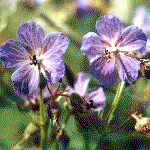 |
GERANIACEAE - The Cranesbill Family
Not surprisingly, this family contains the hardy perennial Geraniums. It also includes Pelargoniums and Erodiums. They are found throughout the temperate and subtropical regions of the world. They are all relatively short plants, mainly grown for ornamental, sometimes with scented leaves, and some are grown for oil of geranium which is used in making perfume. |
Characteristics of this Plant Family:
Leaves, Stem & Roots ~ The stems are often jointed, and may be reddish. The leaves areeither opposite one another or alternate, and may be undivided or lobed or made up of several leaflets. They are often covered with hairs and may have scent glands. Some are evergreen and others are deciduous.
Flowers ~ The flowers of the Geranium family have five sepals and five petals. They are coloured in shades of pink,, red, purple, mauve, blue and white, but not yellow.
Seeds ~ It is the seeds that give this family its name. Geranos is the Greek word for a crane, and the seeds of most members of the family have a long pointed 'beak' in the centre of the seed capsule. There are usually five seeds (although sometimes two seeds may be produced in a single husk), and they are joined together in a circle with the 'bill' in the centre. When the seeds are ripe, the five chambers separate from one another explosively, held on to the 'bill' at their tips, and the seeds are flung from the seed capsule.
The threads which held the chambers together later curl up like springs, and one type is used to make hygrometers, instruments which measure moisture. They curl and uncurl, depending on the volume of moisture in the air.
(Click here for more information and examples of seedpods in this Family.)
Members of this Family usually have:
Blue, mauve, red, pink or white (not yellow) flowers with five petals
Beaked seed capsule
and are short annual or perennial plants